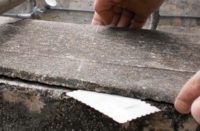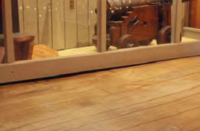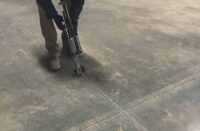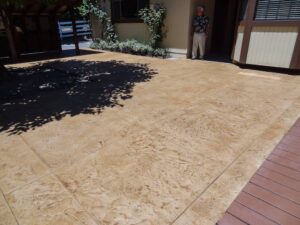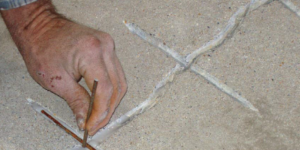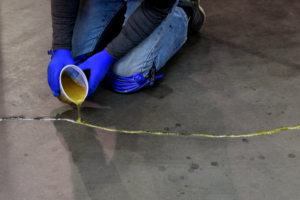
Question: In a recent week, I’ve had two overlay projects with cracking. The first project had lots of short random cracks, the longest about 3 inches long. We noticed them the afternoon of the same day the overlay was applied. The second project had even more cracks, but these are small irregular shapes, almost like a road map. We didn’t see these until we came back and applied a color wash three days after application.
Both projects used the same 1/4-inch overlay applied in a rough trowel finish and a stone pattern hand carved into the surface. The weather was hot with high humidity. Is this a material issue or finish issue? Can it be fixed? Pictures of both are attached.
When it comes to decorative overlays, especially those 1/4- to 1/2-inch thick and in the heat of the summer, you need to treat the application like you’re placing concrete flatwork. For years the focus with overlays has been surface preparation — and for good reason — but what about slump, finishing and curing?
Yes, curing a thick section overlay is important, and yet I don’t see it being done very often. The very fact that these materials are wet (high water-to-cement ratio) and thin makes them prone to surface cracking. When the temperatures are elevated, that risk for cracking increases.

Not all cracks are the same
The pictures indicate two different, but common, types of surface cracking. Both are caused by shrinkage of the concrete surface due to one or more of the following: rapid hydration, wet mix, poor curing and over-finishing the surface. Once again, elevated temperatures increase the risk for cracking.
In both of these cases, the cracking is confined to the surface, doesn’t affect the adhesion or structural integrity of the concrete, and seldom does it affect the durability or wear characteristics of the overlay. However, they are unsightly, don’t look good on a decorative surface and often become an issue with clients when it comes time to getting paid.
Plastic shrinkage cracks
The first case is what is called “plastic shrinkage cracking.” According to the National Ready Mixed Concrete Association, “Plastic shrinkage cracks appear in the surface of fresh concrete soon after it is placed and while it is still plastic…. Plastic shrinkage cracks are caused by a rapid loss of water from the surface of concrete before it has set. The critical condition exists when the rate of evaporation of surface moisture exceeds the rate at which rising bleed water can replace it.”
Even though overlays are “wet” by concrete standards, they are thin, so the amount of actual water is minimal. When working with overlays, the leading cause of these types of cracks comes from a dry substrate. A dry substrate will suck the water out of the overlay, reducing and/or eliminating the amount of water available to replace the water lost to surface evaporation. This is where priming is critical when working with overlays.
It can be a wet primer system, where you work the overlay into the primer when it is tacky or damp, or a dry primer system where an impermeable coating, often a two-part water-based epoxy, is seeded with sand and let to cure fully. The project scope, environmental conditions and overlay system will dictate which primer system to use on the project. It’s also important to select a material that contains fibers, which can considerably help reduce shrinkage cracking.
The upside to plastic shrinkage cracks on overlays is that they can be minimized if certain guidelines are followed during and after placement. Another positive side is they appear early and can be repaired rather easily. If you see them, wait until the material takes an initial set. Then use foam sandals or foam boards to get out on the surface and rub the surface lightly with a damp sponge to close the cracks. If the material has set completely, use the overlay material to create a slurry, fill the cracks with a float or margin trowel, then follow up with a sponge to rub out the surface.
Craze cracking
The second picture is of “craze cracking.” The NRMCA defines crazing as, “the development of a network of fine random cracks or fissures on the surface of concrete or mortar caused by shrinkage of the surface layer.” The cracks are shallow and are more noticeable on smooth troweled surfaces. They are often not noticeable unless the surface is wet or has been sealed with an enhancing sealer.
According to the NRMCA, “Surfaces often have craze cracks due to the shrinkage of the concentrated dense paste layer at the surface.” Since we don’t often hard trowel overlays, this type of cracking is actually pretty rare in the decorative overlay industry. Just like shrinkage cracks, rapid evaporation at the surface is the leading cause, followed by an overly wet mix and over-finishing the surface. Once again heat is a catalyst that increases the chances for this type of cracking.
Curing the surface using a cure-and-seal or plastic will go a long way to reduce this type of cracking. Unlike shrinkage cracks, craze cracking can appear days after finishing, is not always visible, and can be difficult to repair or hide. The nature and volume of craze cracks almost mandate the surface needs to be completely coated to eliminate them.
An ounce of prevention
Courtesy of the NRMCA, here are some rules to follow to prevent both shrinkage and craze cracking when working with decorative overlays:
- Maintain consistency with mix water. Don’t overwater while mixing or add water to the surface while finishing.
- Avoid excessive manipulation of the surface, which can depress coarse aggregate, increase the cement paste at the surface or increase water-to-cement ratio at the surface.
- Don’t finish while the surface is wet or still has bleed water present.
- Don’t apply dry overlay powder or cement powder to the surface.
- Dampen the substrate when high evaporation rates exist.
- Create wind breaks or fog the surface to prevent rapid evaporation.
- Cover the surface with plastic sheets between finishing operations.
- Cool overlay materials prior to use to reduce material temperature.
- Cure properly as soon as finishing has been completed.
